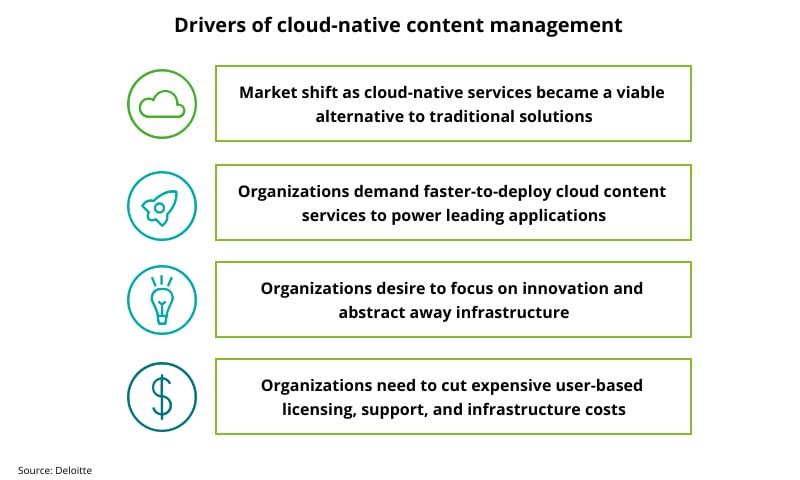Redefining Content Services in a Cloud-Native World | Deloitte US has been saved
A blog post by Michael Carlino, Principal, Digital Content Advantage, Center for Process Bionics, Operations Transformation—Core Business Operations, Deloitte Consulting LLP; Vikram Sharma, Specialist Leader, Operational Transformation—Core Business Operations, Deloitte Consulting LLP; Sangeet Rajan, Operations Transformation and Digital Strategy Advisor, Deloitte Consulting LLP
The evolution of cloud services presents an intriguing opportunity for companies to shift from an enterprise content management (ECM) philosophy to cloud-native content services. This blog explores the evolution of content services, its defining characteristics, and how an orchestrated and containerized set of microservices, built as an integrated cloud-native content services product suite, could become the modern and cost-effective alternative to legacy, big-box ECM platforms that preceded it. We also delve into available implementation options for content services.
The ECM to content services evolution
Over the past decade or so, there’s been a consistent evolution in enterprise content management, from early ECM to cloud content services.
Crawl: Early ECM
Big-box and monolithic, early ECM met the need for a single vendor to centralize content and compliance repositories. Feature-rich with heavy footprints, these platforms were meant to be directly consumed by users. The content usage experience was cumbersome and disconnected, resulting in low adoption and the inability to unleash the full value of enterprise content.
Walk: API-wrapped ECM
Vendor focus initially shifted to API-wrapped big-box content services that delivered “content in context” within core business applications for improved usability. Later, the software was ported to cloud and offered as a managed service with RESTful APIs enabled. However, the underlying fundamental architecture, proprietary code base, and pricing remained the same. Traditional platforms were yet to fully exploit the inherent auto-scalability and elasticity that comes from serverless deployments to cloud.
Fly: Cloud-native content services
Cloud object storage, artificial intelligence/machine learning (AI/ML), natural language processing (NLP), and archiving services have emerged as a feasible and cost-effective alternative to big-box content management platforms. These services, when orchestrated, can be built into a full-featured content services platform. Headless, lightweight, easy to deploy, auto-scalable, and hyper-elastic content services allow companies to shift away from heavyweight infrastructures, expensive user-based licensing models, and high operational costs of the past.
Why companies should consider a cloud-native content services platform
Organizations going through application modernization or cloud transformation journeys have various business needs for content services. With the shift to cloud comes the potential for benefits such as greater speed of business, reduced operating costs, IT simplicity, and enhanced security.
Companies are rapidly deploying new Software-as-a-Service (SaaS) platforms to transform their business processes to help deliver on cloud’s potential. These deployments come with the need for advanced content services for the following processes:
- High-volume touchless processing—AI/ML and NLP-infused extraction and automation of data-rich documents such as loan applications, referrals, invoices, and claims to automate manual tasks and reduce processing costs.
- Centralized repository—Elastic, scalable, single-pane-view repository that facilitates cross-cloud collaboration and access to “single source of truth” documents within and across multiple SaaS applications while reducing the infrastructure footprint and containing operational costs and licensing fees.
- Records compliance—Enhanced records capabilities such as support for retention schedules, holds management, search, and content disposition that enable reduction in the compliance costs.
- Replatforming—Replatforming with cloud content services to replace legacy platforms and reduce high license, infrastructure, support, and maintenance costs.
- Decommissioning—Decommissioning end-of-life legacy applications and offloading data to a central and compliant archiving solution so only relevant data and content is brought to the cloud.
But why?
Despite the clear benefits of cloud content services, questions often arise that require clarification:
- Why not store documents on a file server and maintain links directly in the core systems?
- Why not use the document storage features in SaaS platforms instead?
- Why not use collaboration tools as the document management solution instead?
- Why even store documents?
Unpacking the why not
Linking to documents stored directly on a file server creates the following traceability and manageability issues:
- Content sprawl, duplication, and redundancy
- Version confusion
- Poor content auditability
- Low usability with poor search experiences (due to the lack of rich metadata and taxonomy)
- Limited enforcement of access and information security controls
- Inability to apply records management policies
Using document storage features in SaaS applications may also create the following issues:
- Expensive storage subscription fees to increase allocations for storing high volumes of documents
- Higher user-license costs to enable casual or non-user access to documents
- Difficulty sharing documents in cross-cloud collaboration scenarios
- Limited ability to support advanced records management and compliance capabilities
- Limited capabilities to ingest, classify, and extract data from millions of pages of data-rich documents and enable touchless processing
Collaboration tools work well for departmental or project interactions, but using these tools as an enterprise document management solution often results in ungoverned, siloed repositories. Content, site, and group sprawl are common pain points when leveraging the tools. Further, access controls are difficult to enforce, and risk of unauthorized access to information grows. Records management compliance is also challenging as information policies are not applied consistently.
Documents are corporate memory. They are critical assets that contain business insights and drive business processes. Regulators also require corporate records to be kept in line with retention requirements. Therefore, not storing the documents is not an option.
Characteristics of a CSP
Now that these questions are unpacked, let’s explore the characteristics of a cloud-native content services platform (CSP).
API first and headless
A CSP should be built API-first and headless, as a base set of orchestrated content microservices and connectors, consumable “in-context” within a transaction and in a user-centric manner by a core system. For example, APIs for capture, extraction, classification, indexing, search, version control, workflow, and more that are consumable by core business applications. Pre-built connectors for applications from major SaaS providers are also essential.
Serverless and elastic
A CSP’s components should support containerized, serverless deployments, to enable on-demand and elastic scalability. This architecture abstracts away many layers of infrastructure--networks, servers, operating systems, backup, disaster recovery, etc. so that companies can focus on business innovation, not infrastructure.
AI/ML-infused intelligent automation
A CSP’s services should include support for intelligent automation by natively exploiting AI/ML, NLP, robotic process automation (RPA), and other core microservices available from the hyperscalers to enable touchless processing. This approach enables companies to take advantage of the massive investments and innovations that cloud providers are making in their AI/ML capabilities.
Consumption-based pricing
A CSP should support pay-as-you-consume pricing to lower the total cost of ownership (TCO) for content services for companies. This pricing enables a significantly more attractive alternative to the expensive user-based licensing of traditional platforms.
Potential options
Cloud object storage, AI/ML, NLP, and archiving services from cloud providers have evolved as a feasible and cost-effective alternative to big-box content management platforms. These services surpass the functionality of legacy platforms. Companies can build a full-featured CSP by orchestrating these services in-house or with the help of a systems integrator to enable a scalable enterprise content platform.
Alternatively, Deloitte has a pre-orchestrated cloud content services solution (DocuEdge) that can be deployed at scale within an enterprise, enabling a true cost-effective content services utility. DocuEdge Capture, Vault, and Archive are three independently deployable components that orchestrate services for intelligent document automation, document repository, and compliant information archiving.
The bottom line
Although at first glance, the implementation of a brand-new CSP to replace a legacy platform may seem to be a daunting and massive undertaking, the business case for the switch is easy to make. We have seen immediate return on investment with payback periods of less than a year in most cases. Companies have realized multimillion-dollar cost savings in license, infrastructure, and operational costs alone.
Get in touch

David Linthicum
As the chief cloud strategy officer for Deloitte Consulting LLP, David is responsible for building innovative technologies that help clients operate more efficiently while delivering strategies that enable them to disrupt their markets. David is widely respected as a visionary in cloud computing—he was recently named the number one cloud influencer in a report by Apollo Research. For more than 20 years, he has inspired corporations and start-ups to innovate and use resources more productively. As the author of more than 13 books and 5,000 articles, David’s thought leadership has appeared in InfoWorld, Wall Street Journal, Forbes, NPR, Gigaom, and Lynda.com. Prior to joining Deloitte, David served as senior vice president at Cloud Technology Partners, where he grew the practice into a major force in the cloud computing market. Previously, he led Blue Mountain Labs, helping organizations find value in cloud and other emerging technologies. He is a graduate of George Mason University.


